The best intermediate guitars appeal to those that have been playing for a while and are looking to upgrade their instrument. This is a natural progression, as once you develop more technique and have more experience, you’re likely to wish for a guitar that responds better and is more comfortable to play as well.
Naturally, intermediate guitars tend to cost a few hundred dollars more than beginner models. For this, you get higher quality parts and often better construction.
Companies know this too well, and therefore the market is flooded with intermediate guitars of all types. From solid bodies to semi-hollow bodies, single coils to humbucker models, and anything in between, there are plenty of options.
With so many choices, how do you know what to get? We are here to help. Keep reading.
Read more about our review process.
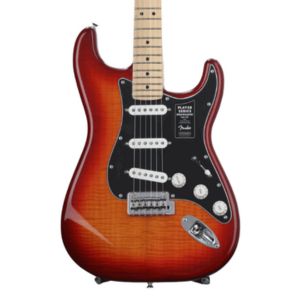
Fender Player Stratocaster Plus Top
Features: Flamed maple top, Alnico 5 single coil pickups, Modern C neck profile
Benefits: Great playability, Huge tonal range, Solid reliability
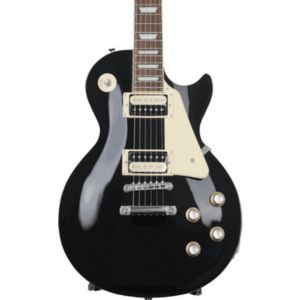
Epiphone Les Paul Classic
Features: Alnico Classic PRO humbuckers, Coil splitting, Wilkinson tuners
Benefits: Thick Les Paul tones, Fast neck, Great tuning stability

Yamaha PAC112VM Pacifica
Features: HSS pickups, Alder body, Push pull humbucker
Benefits: Lightweight and comfortable, Superb build quality, Massive range of tones
Contents
Our Top 3
The Epiphone Les Paul Classic is -our Top pick as it features the traditional body wood combination of mahogany and maple. This instrument delivers a rich and warm resonance and is a fantastic intermediate electric guitar.
The Yamaha PAC112VM Pacifica is our Best Budget choice. It features an alder body on a nice looking gloss polyurethane finish. With a full-bodied and clear tone, you get single coil twang with a humbucker on the bridge position for greater versatility.
Finally, the Fender Player Stratocaster Plus Top is our Editor’s Choice. Featuring an alder body with a flamed maple top you get great tone and fast action on the 22-fret maple fingerboard and neck. This guitar is for folks that want greater quality in an intermediate guitar.
Individual Reviews
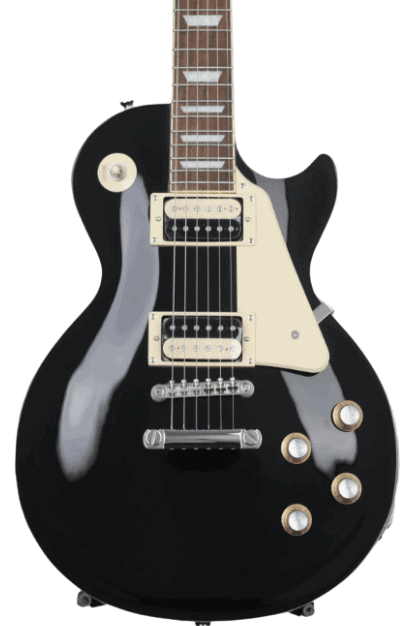
Epiphone Les Paul Classic
A great Les Paul model made overseas.
Epiphone has been under the umbrella of Gibson for years. Therefore, it is the only brand that can produce and sell Gibson designs legally. The Epiphone Les Paul Standard is an inexpensive copy of the prized original. Made in Asia in order to lower costs, you get a Les Paul without the inflated price tag.
The Epiphone Les Paul Classic features the tried-and-true body wood combination of mahogany and maple. Plugged into our Fender Twin Reverb with our Tube Screamer, this Epiphone gave us rich and warm resonance, just as we’d expect with a Mahogany solid body.
Power chords and leads had a nice amount of clarity and definition, with a bit of snappy top thanks to the maple top. We particularly liked how distorted riffs and power chords sounded on the bridge pickup, with a penetrating quality.
This Epiphone also delivers nice sustain, which is also one of the most desirable traits of Les Pauls. This guitar comes with two Alnico Classic PRO humbuckers on both the neck and bridge position, with Alnico V magnets.
The bridge pickup is great for cutting through a mix, with enhanced mids and plenty of highs, which is ideal for rock and blues. Moving on to the neck pickup on clean, we got a warm sound that can work nicely for blues and jazz. For even greater flexibility, this Epiphone Les Paul Classic comes with coil-splitting so you can also get some single coil tones.
The playability on this guitar is truly what you’d expect from a modern Les Paul. It comes with a SlimTaper neck that feels great, as it is made of mahogany with an Indian laurel fingerboard.
In short, a fantastic Les Paul guitar with a fair price, and an ideal choice for folks that want a warm and sustained tone without the high price.
Verdict: The Epiphone Les Paul Classic comes with the beloved tonewood combination of mahogany and maple. Made overseas to keep costs down, this Les Paul gives you rich and warm resonance, with great playability.
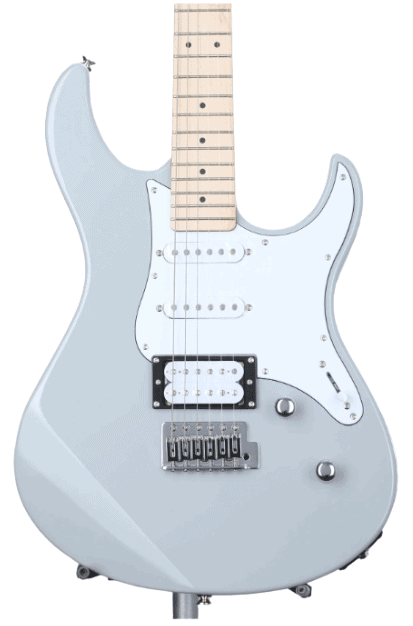
Yamaha PAC112VM Pacifica
A Strat-type guitar with great value.
The Pacifica line of electric guitars by Yamaha has been popular for a while. With plenty of models to choose from, Pacifica guitars are used by everybody, from beginners to pros, including jazz fusion master Mike Stern. This guitar is a great option for beginners that want a good instrument to start with.
The Yamaha PAC112VM Pacifica features an alder body on a gloss polyurethane finish that gives it a smooth look. Alder is popular for solid body electric guitar bodies because it offers a full-bodied and clear tone. That much was true when we plugged into our Roland JC-120 to try this guitar out.
We liked that this guitar features a custom Yamaha ceramic Alnico V humbucker at the bridge position. With distortion dialed in via our Ibanez Tube Screamer, we got a powerful punch for riffs and power chords, great for rock and even heavy metal with more aggressive gain.
We then split the humbucker via the push/pull tone control and got a crisp single-coil tone. Although this makes the guitar more versatile, we preferred the power provided by the humbucker on the bridge.
Both the middle and neck position pickups are Alnico V single coils that gave us that snappy tone that Strats are beloved for. In clean, we loved the tone we got in position four, perfect for funk rhythms that cut through.
With a bit of distortion, both the middle and neck pickup gave us useful tones for blues soloing that had that single coil attack to them.
This guitar also has nice playability, as it comes with a C-shaped maple neck and a responsive maple fingerboard. With a 13.75″ radius and a 25.5″ scale length, we felt comfortable with this guitar at all times. In short, a fantastic instrument for any beginner looking to start out right.
Verdict: The Yamaha PAC112VM Pacifica comes with an alder body and offers you a clear tone on a lighter and more affordable instrument. With Alnico V single coils and a custom-designed Yamaha humbucker at the bridge position, this is a versatile guitar that is perfect for students and beginners.

Fender Player Stratocaster Plus Top
The ultimate solid body for intermediate players.
The Fender Stratocaster is the classic solid-body electric guitar. For intermediate players, it is one of the best choices, as you can get a good instrument at a fair price. The Stratocaster Plus Top offers superior quality and playability for less than a grand.
The Fender Player Stratocaster Plus Top features an alder body with a flamed maple top that gives it a look reminiscent of some of Stevie Ray Vaughan’s Strats. The first thing we noticed and liked when playing it was the fast action on the 22-fret maple fingerboard and neck. Strats are not particularly known for fast action, especially at this price range.
Our hands felt comfortable while playing with the modern C-shape neck, featuring a 9.5″ radius and your typical Fender 25.5″ scale length. With a synthetic bone nut of 1.650″ in width, this Strat gave us that familiar and beloved Fender feeling while playing.
Plugged into our Twin Reverb, we started by testing the pickups in clean. All three are Player Series Alnico 5 Strat single coil pickups that deliver all the traditional present tones with the characteristic twang that you would expect from a Strat. The tone at the bridge position was great for some chicken picking, while position four was our favorite for clean open chords and rhythm playing.
With distortion, we loved the penetrating growl at the bridge pickup. With just overdrive, we preferred position two for a nice bluesy soloing that can work nicely in many contexts.
Interestingly, in the Player Series Strat, the Tone 1 knob affects both the neck and middle pickups, while the Tone 2 knob is exclusively for the bridge pickup.
We also liked the Fender 2-point “Synchronized Tremolo” system, and it proved to be stable during our tests. In short, a fantastic Strat for less than a thousand dollars offers you better tone and playability than most at that range.
Verdict: The Fender Player Stratocaster Plus Top comes with an alder body and a fast-playing action on a maple fingerboard and neck. This Strat delivers authentic single coil twang and attitude, with great tone, playability, and features, particularly at this price.
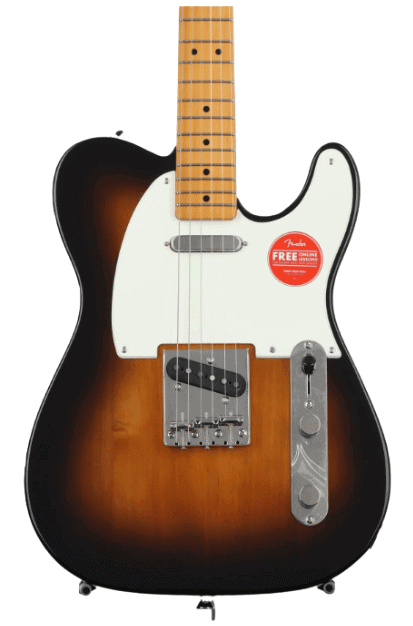
Squier Classic Vibe '50s Telecaster
Tele tone and feel with a vintage flair.
The Telecaster is one the most popular guitars in history, and for good reason. With its simple yet effective design, you get versatility and plenty of attitude with a signature twangy tone. This Squier pays homage to the Telecasters from the 50s in both tone and feel.
The Squier Classic Vibe ’50s Telecaster features a pine body with a gloss polyurethane finish. It comes with Fender-designed alnico single-coil Tele pickups in both the neck and bridge positions. Plugged into our Fender Twin Reverb, the bridge pickup gave us a forward and twangy Tele clear tone that is good for playing country and even a bit of blues.
With some overdrive, the bridge pickup gave us a powerful tone that works well for soloing, especially in blues, country, and rock. For more aggressive distortion, we preferred the neck pickup, as the tone was rounder and more pleasing to our ears. All of our overdrives and more distorted sounds came courtesy of our Ibanez Tube Screamer, which pairs well with most guitars, including this Telecaster.
The neck pickup also did a good job for cleans, and can even be used for some jazz if need be. Although pine tends to be a bit lighter, this Telecaster weighs in at a bit over 8 lbs, which is standard for a Tele. We expected it to be a bit lighter, as a tradeoff for the more limited projection that pine offers.
The playability on this Tele is closer to what you’d get from a vintage Tele. We liked how the maple neck and its “C” profile felt, with a good dose of familiarity that many Fender players are likely to appreciate.
With a traditional maple fingerboard that felt nice, this Squier Telecaster comes with a 9.5″ radius, and the typical 25.5-inch scale length that is common with Fender guitars. In short, a nice Tele from Squier, at a great price.
Verdict: The Squier Classic Vibe ’50s Telecaster gives you vintage Tele playability and tones at a low cost. With Fender-designed alnico single-coil Tele pickups, this guitar delivers a twangy Tele clear tone and pairs well with distortion pedals.
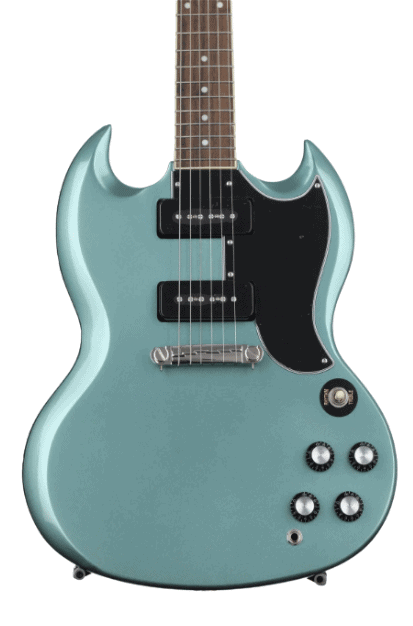
Epiphone SG Special P-90
A classic with single coil variation.
From Angus Young to early Carlos Santana, the SG guitar is a staple of rock and blues. This particular model trades the traditional humbucker pickups for P-90s single coils and offers you Gibson-type detail but at the cost of an Epiphone.
The Epiphone SG Special P-90 features a mahogany body with a gloss finish. The first thing we loved about this guitar is how light it is. At just 7.1 lbs, we loved how comfortable it is to carry, which is a big plus for folks that play long gigs.
The second thing we really liked about this guitar was the 1960s SlimTaper neck profile which gave us a fast touch and great playability. These types of necks are a bit thinner than similar ones from the 50s, and nicely complete the comfort aspect that this guitar offers.
With a 12″ radius and Indian laurel fingerboard, this Epiphone SG was responsive to our dynamics and overall playing, especially at higher distortion settings. The 24.724″ scale length and 1.6892 nut width also gave us that typical feeling that many Gibson necks feature and that is beloved by many.
For many though, the most attractive trait of this guitar will be the Epiphone’s P-90 Pro soap bars pickups. Inspired by the original designs from the iconic Seth Lover, these single-coil pickups gave us versatility with a unique gritty flavor.
Although we liked how they sound clean, these pickups are at their best when distorted. We got a bright and present tone for both overdrive and distortion on the bridge pickup and a bit darker and very musical tone for the neck pickup.
In short, a nice Epiphone that gives you nice playability and tone. Naturally, the P-90 sound is not for everybody, so keep that in mind before you buy.
Verdict: The Epiphone SG Special P-90 comes with a resonant mahogany that is very light. It offers the unique flavor and tone that P-90s pickup is renowned for in a tried and true SG body type that many players love.
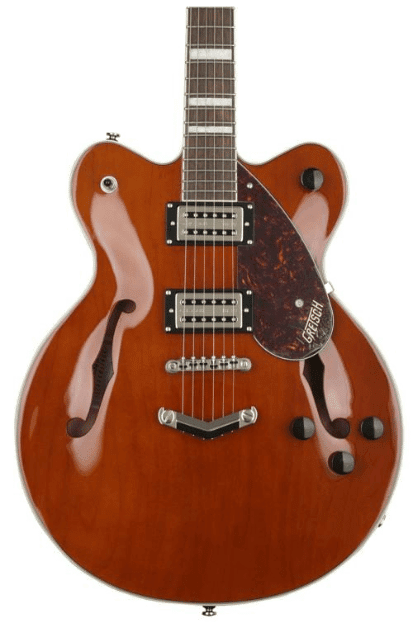
Gretsch G2622 Streamliner Center Block
A nice semi-hollow body for beginners.
Gretsch has been a highly reputable brand for decades, as they have consistently offered quality instruments. The Streamliner series aims to bring affordability to the brand while retaining some of the key qualities that have made Gretsch so popular.
The Gretsch G2622 Streamliner Center Block is a semi-hollow-body guitar that features a laminated maple body and two Single Barrel Stain pickups.
This guitar felt a bit bulky in our hands, but it gave us a nice acoustic quality and response when we tried some Freddie Green-style big band comping, unplugged. The tuning and intonation were mostly stable while we chugged along chords in this style of playing.
Plugging into our Twin Reverb, we got a warm tone at the neck pickup, great for jazz soloing, as well as solo playing. We actually preferred it with the tone rolled up a bit, otherwise, the sound was a bit too dark with not enough definition.
The neck pickup on clean was also better with the tone at higher settings, for enhanced clarity. The bright and forward tone we got here can be used for rockabilly and even some pop contexts.
With a bit of overdrive, we got a decent tone for leads, particularly at the bridge position. This is where the sound was more penetrating and could work well in a variety of contexts. On the other hand, the neck pickup was a bit dull when overdriven or distorted.
The neck on this guitar is made of nato, and the fingerboard is laurel, which felt nice and was responsive to our playing. Regarding the hardware, Gretsch was smart not to include a Bigsby as it would probably affect this guitar’s stability, as is the case with other Bigsby-equipped instruments at this price range.
In short, a good guitar for folks looking for a hollow body, particularly those interested in jazz and rockabilly.
Verdict: The Gretsch G2622 Streamliner Center Block is a semi-hollow-body with a laminated maple body and a good choice mostly for beginners or jazz students. With two Single Barrel Stain pickups, this guitar delivers a nice acoustic quality and response and warmth when plugged in.
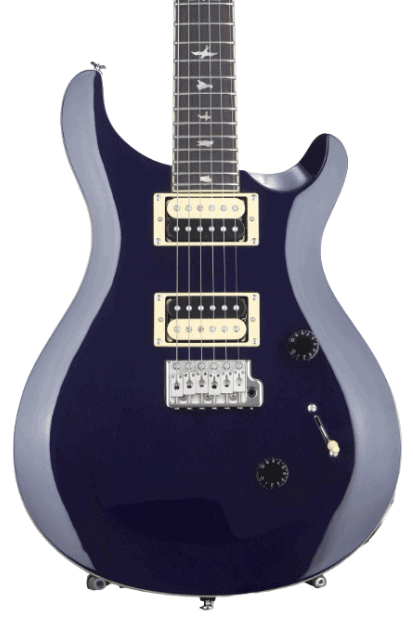
PRS SE Standard 24
Versatility with renowned PRS tone and playability.
SE guitars by PRS are made overseas in order to keep the costs down while delivering nice quality. That is certainly the case with this guitar, based on PRS's popular Standard 24 solid body model.
The PRS SE Standard 24 features a mahogany construction with a gorgeous translucent blue gloss finish. It comes with a set of 85/15 “S” pickups, modeled after the 85/15 pickups that Paul Reed Smith designed for the brand’s 30th anniversary.
We started by trying out the neck pickup on clean where we got a well-defined tone that was penetrating, particularly with the tone knob all the way up. With a bit of distortion via our Tube Screamer, this pickup was great for soloing in different contexts and making sure your sound cuts through a dense live mix.
For heavier uses like rock riffing and power chords, the neck pickup was ideal. It gave us tons of growl at heavier settings, with a beefy yet well-balanced tone with great string clarity. This pickup was also nice for leads, with a rounder tone with nice sustain.
We also like the neck pickup on clean, as it gives us a warm tone that can be used for jazz, especially with the tone knob rolled up to about three.
For increased versatility, this PRS SE comes with a push-pull tone pot for coil splitting, giving you access to shimmering single-coil tones.
The playability on the SE Standard 24 is also nice. We liked the rosewood fingerboard, and the slim 10″ radius, as well as the 25″ scale length. To round it off, this guitar comes with PRS’s traditional birds in flight inlaid in mother-of-pearl.
In short, a fantastic and versatile guitar for the money.
Verdict: The PRS SE Standard 24 features a mahogany construction with a gorgeous translucent blue gloss finish. It comes with a set of 85/15 “S” pickups, modeled after the 85/15 pickups that Paul Reed Smith designed for the brand’s 30th anniversary.
How to Choose The Right Electric Guitar For You
Intermediate guitars tend to cost somewhere between 500 Dollars to a grand, give and take. At this price range, you can get a good instrument to keep growing as a player.
At the intermediate level, you probably have developed a preference for certain guitar types. Or perhaps you are looking to change direction altogether and get something new. For instance, if you have played a single coil solid body, you may want to go for a semi-hollow body with humbuckers.
Whatever the case may be, it is important to keep some aspects in mind. We listed a few of the most important below. These will help you narrow your search for your new intermediate guitar.
Tonewoods
The particular woods used in electric guitar construction will have a clear impact on your tone and sustain. Keep in mind that the part of the guitar the wood is used on also makes a difference. Some woods, however, will work well for the top, neck, and fretboard as well. Below we list some of the common choices.
Alder
Alder is a popular choice for guitar bodies. It is lightweight and offers a balanced tone, where all frequencies are well represented.
Ash
Ash is an open-grain wood known for providing a balanced tone, with a nice upper-midrange, clear bass, and scooped mids.
Basswood
Typically used for inexpensive instruments, you can also get good results with basswood. This wood tone makes for lighter guitars that give you a warm tone and strong mids.
Mahogany
One of the most popular guitar woods, particularly for necks and fretboards. It is also used for guitar bodies and produces a warm tone with great sustain.
Maple
Maple is also extremely popular and delivers great results for the body, neck and fingerboard. It is somewhere between medium to heavy in weight, and gives you a very bright tone with long sustain.
Poplar
Poplar is lightweight and very popular in inexpensive guitars. It gives you a bright and crisp tone but is not known for providing great sustain.
Pickups
Pickups have a massive effect on the tone of your guitar. It is important to understand their basic functioning and the sound that they provide.
Single-coils
The first electric guitars came with single-coil pickups, aptly named as they only had one coil of wire. Single-coil pickups produce a thin, penetrating and clean, transparent sound. For instance, Fender guitars became the paradigm for single-coil sound, specifically models like the Stratocaster and Telecaster. Icons like Jimi Hendrix and Stevie Ray Vaughan obtained single coil toned that is revered to this day.
Single coils are also known to be prone to hum. Although some players like that and used it to their advantage, said hum proved to be an issue for some.
Humbuckers
Humbuckers are typically associated with Gibson guitars and are not prone to “humming” in the presence of electrical interference. They use two coils and either two magnets, or pole pieces located at opposite ends of a magnet.
Humbuckers produce a warm and smooth tone. The Gibson Les Paul became the modern paradigm for a humbucker guitar and is still widely used for rock, blues, pop, and jazz. Legends like Jimmy Page, BB King and Wes Montgomery played Gibson guitars with humbuckers, producing tones that are widely imitated to this day.
In order to get the best of both worlds, some guitars offer a combination of single coils and humbucker pickups. Others provide a switch that allows the player to split the coil and go from humbucker to single coil sound.
Final Thoughts
Intermediate guitars cost a bit more but improve both their quality and playability when compared to beginner models. It is only natural to wish for a better guitar, and the jump from beginner instrument to intermediate is often significant in terms of quality.
f you’re in the market for an intermediate electric guitar, there are some key things to bear in mind. You want a guitar that’s solidly built; it should feel like it’s able to withstand some serious playing. Sound quality is a major consideration too – look for a guitar that can deliver a broad range of tones to suit different musical genres. Don’t overlook the importance of pickups; a combination of humbucker and single-coil can offer you a wide palette of sounds to play with.
Finally, comfort can’t be ignored. The guitar should feel good in your hands, with a neck that’s the right fit, a fretboard that’s smooth to the touch, and action that’s just right. In essence, a great intermediate electric guitar should offer a blend of durability, sonic versatility, and ease of play.
To recap our choices, the Epiphone Les Paul Classic is our Top pick, for rich and warm resonance on a more affordable Les Paul body. With powerful humbuckers, you get Gibson playability but on an Epiphone price tag.
The Yamaha PAC112VM Pacifica is our Best Budget choice. It features an alder body on a pretty gloss polyurethane finish and delivers a full-bodied and clear tone and nice versatility.
Last but certainly not least, the Fender Player Stratocaster Plus Top is our Editor’s Choice. Featuring an alder body and nice playability, this guitar is for folks that want to spend a bit more in order to get greater quality in an intermediate guitar.


